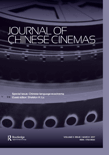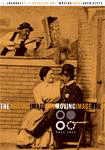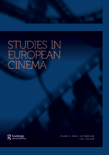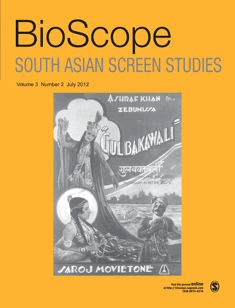
Journal of Chinese Cinemas
Scope & Guideline
Exploring the Depths of Chinese Cinematic Artistry
Introduction
Aims and Scopes
- Cultural and Historical Analysis:
The journal emphasizes the historical context of Chinese cinema, examining its evolution from early cinema to contemporary forms, and how these reflect broader social changes. - Interdisciplinary Approaches:
It employs a variety of methodologies, incorporating perspectives from cultural studies, media studies, and sound studies, allowing for a rich analysis of film and its societal implications. - Focus on Queer Cinema and Gender Studies:
The journal frequently addresses themes of gender and sexuality, particularly within the realm of queer cinema, exploring how these narratives shape and are shaped by Chinese cultural contexts. - Technological Impact on Cinema:
There is a significant focus on the role of technology in shaping cinematic experiences, including the impact of digital media and user-generated content on film production and reception. - Regional and Transnational Perspectives:
The journal examines cinema not only within the context of mainland China but also its relationship with Hong Kong, Taiwan, and the global diaspora, highlighting the transnational flow of cinematic ideas.
Trending and Emerging
- Sonic Studies and Acousmatic Sound:
There is a notable rise in the exploration of sound in cinema, particularly acousmatic sound and its implications in urban settings, which reflects a growing interest in how soundscapes shape cinematic experiences. - Queer Cinema and LGBTQ+ Representation:
The journal has increasingly focused on queer cinema, analyzing its cultural implications and the representation of LGBTQ+ narratives within Chinese cinema, highlighting the importance of these themes in contemporary discourse. - User-Generated Content and Digital Activism:
Emerging discussions around user-generated content and its role in documentary filmmaking suggest a trend towards examining how digital platforms and grassroots movements influence cinematic narratives and activism. - Interdisciplinary and Cross-Cultural Studies:
There is an increasing trend towards interdisciplinary approaches that integrate various cultural contexts, such as the examination of Sino-foreign collaborations and cross-cultural cinematic influences. - Environmental and More-than-Human Perspectives:
Recent articles reflect a growing interest in environmental themes and more-than-human perspectives in filmmaking, indicating a shift towards recognizing the interconnectedness of cinema, ecology, and society.
Declining or Waning
- Traditional Historical Narratives:
There appears to be a diminishing focus on conventional historical narratives of Chinese cinema, particularly those that concentrate solely on mainstream or state-sponsored films without critical engagement with alternative or independent cinema. - Film Criticism and Reviews:
The journal has shifted away from more generalized film criticism and reviews, moving towards more specialized and theoretical discussions, which may leave less room for broader audience-oriented critiques. - Focus on National Identity:
Discussions centered on national identity in Chinese cinema have become less pronounced, possibly reflecting a shift towards more global or transnational perspectives that challenge singular narratives of national cinema.
Similar Journals

Moving Image
Navigating the Landscape of Moving Image StudiesMoving Image is a distinguished academic journal published by University of Minnesota Press, dedicated to the exploration and critical analysis of visual culture. With an ISSN of 1532-3978 and an E-ISSN of 1542-4235, this journal plays a vital role in advancing scholarship in the fields of Conservation, Visual Arts, and Performing Arts, offering insights from its notable publication history from 2013 to 2019 and again from 2021 to 2022. While it currently does not offer open access options, the journal is recognized as a crucial platform for disseminating research, reflected in its rankings—#442/667 in Visual Arts and Performing Arts and #87/103 in Conservation according to Scopus. Despite its placement in the Q4 quartile for both fields, Moving Image remains a key resource for scholars, students, and practitioners interested in the intricate dynamics of moving images in contemporary culture. Its commitment to fostering dialogue and innovation in visual studies ensures its relevance and influence within the academic community.

FILM CRITICISM
Bridging Theory and Critique in Film StudiesFILM CRITICISM is a prestigious open-access journal dedicated to the study and review of cinema, offering a platform for scholars, critics, and students to engage deeply with the evolving landscape of film. Published by Film Criticism and based in the United States at Allegheny College, this journal has been contributing to film studies since 2002, with recent issues spanning from 2023 to 2024. Registered under ISSN 0163-5069, it is recognized in the Visual Arts and Performing Arts categories, achieving a commendable rank of #372 out of 667 in Scopus, placing it in the 44th percentile of its field. With an open-access policy implemented since 2016, FILM CRITICISM not only broadens accessibility to scholarly work but also enhances the dialogue around cinematic narratives, theories, and critiques. The journal's relevance is underscored by its current Q3 ranking, making it an essential resource for researchers and professionals alike who are invested in the critical examination of film.

Canadian Journal of Film Studies-Revue Canadienne d Etudes Cinematographiques
Bridging Canadian Perspectives with Global Cinematic PracticesCanadian Journal of Film Studies-Revue Canadienne d'Études Cinématographiques is a distinguished publication dedicated to the exploration of film studies within the context of Canadian cinema and global visual arts. Published by University of Toronto Press Inc., this journal offers a platform for innovative and critical scholarship, having achieved a notable Q2 ranking in the Visual Arts and Performing Arts category for 2023, with an impressive Scopus rank of 207 out of 667, positioning it in the 68th percentile among peers. With a continuous publication record since its established years from 1998 to 2001 and 2004 to 2024, it has become an essential resource for researchers, professionals, and students interested in the evolving landscape of film and cinema. The journal not only addresses theoretical perspectives but also engages with contemporary practices, thereby fostering a deeper understanding of cinematic arts. Despite not offering open access, it remains a vital repository of knowledge for those seeking to advance their studies and contribute to the discourse in film studies.

Studies in Eastern European Cinema
Connecting Scholars to the Heart of Eastern European CinemaStudies in Eastern European Cinema is a distinguished journal dedicated to exploring the rich and diverse landscape of cinematic art in Eastern Europe. Published by Routledge Journals, Taylor & Francis Ltd, this journal has carved a unique niche since its inception in 2010, providing insightful analysis and fostering dialogue among scholars, professionals, and students in the fields of Communication and Visual Arts and Performing Arts. With a current impact factor reflected in its respective quartile rankings, which position it in Q4 in Communication and Q2 in Visual Arts and Performing Arts, the journal serves as an essential platform for research and discourse on the cinematic contributions of Eastern Europe. Featuring contributions that analyze historical contexts, artistic trends, and cultural implications, it aims to broaden the understanding of Eastern European cinema's role within the global film landscape. While it offers a traditional subscription model, its ongoing commitment from 2010 to 2024 ensures it remains at the forefront of academic inquiries, appealing to a growing audience dedicated to the appreciation and scholarship of Eastern European cinematic arts.

Chinese Historical Review
Fostering Scholarly Dialogue on China's Cultural LegacyChinese Historical Review is a premier scholarly journal published by ROUTLEDGE JOURNALS, TAYLOR & FRANCIS LTD, dedicated to advancing the understanding of Chinese history and its cultural contexts. With an ISSN of 1547-402X and an E-ISSN of 2048-7827, this journal serves as an essential resource for researchers, professionals, and students alike. Its impact factor reflects its quality and significance in the field, categorized in the Q2 for History and Q3 for Cultural Studies as of 2023, underpinning its authority in the humanities. Covering a diverse range of topics related to Chinese historical perspectives, the journal aims to foster interdisciplinary dialogue and provide a platform for innovative research. Complementing its scholarly rigor, the journal ranks #678 out of 1760 in the Arts and Humanities History category and #652 out of 1304 in Social Sciences Cultural Studies, positioning it within the 50th to 61st percentile. Chinese Historical Review is vital for anyone looking to deepen their understanding of China's rich historical tapestry and its implications on contemporary society, making it a must-read for those engaged in historical and cultural studies.

Studies in European Cinema
Advancing Critical Discourse in European CinemaStudies in European Cinema is an esteemed journal published by Routledge Journals, Taylor & Francis Ltd, focusing on the multifaceted realms of European cinema and its contextual relevance. With an ISSN of 1741-1548 and an E-ISSN of 2040-0594, this journal provides a dynamic platform for researchers and practitioners in the fields of Communication, Visual Arts, and Performing Arts. As reflected by its recent Scopus rankings, it holds a respectable position in the Arts and Humanities with an 84th percentile rank, indicating its significance and impact in the scholarly community. While not entirely open access, Studies in European Cinema seeks to foster critical discourse and analysis from 2004 to 2024, covering a broad spectrum of topics related to film studies, cultural representations, and the evolving narratives within European cinematic practices. Engaging with diverse theoretical frameworks, the journal aims to contribute to the vibrant dialogue surrounding European cinema, making it an essential resource for academics, filmmakers, and students alike who are passionate about exploring cinematic expression in a European context.

French Screen Studies
Charting New Frontiers in Film and Media StudiesFrench Screen Studies is a distinguished journal published by Routledge Journals, Taylor & Francis Ltd, focusing on the dynamic interactions between film, media, and cultural studies within the context of French cinema. Since its inception in 2020, the journal has contributed significantly to the academic landscape, providing a platform for innovative research and critical discussion on visual arts and performance as reflected in its prestigious Q1 ranking in Visual Arts and Performing Arts for 2023. Despite being a burgeoning journal, it holds an impressive position within Scopus rankings, particularly in the Arts and Humanities sphere. Researchers and scholars will find the journal a vital resource, as it endeavors to explore the intersections of screen studies with broader social and cultural implications. Although currently not open access, French Screen Studies continues to foster an inclusive dialogue among academics, paving the way for future exploration of France’s influential cinematic heritage.

Bioscope-South Asian Screen Studies
Transforming Perspectives on South Asian MediaBioscope-South Asian Screen Studies is an influential journal dedicated to advancing the field of screen studies in the South Asian context, published by SAGE Publications India Pvt Ltd. With an ISSN of 0974-9276 and an E-ISSN of 0976-352X, this journal spans a convergence of scholarly research from 2010 to 2024, providing a significant platform for interdisciplinary dialogue. Holding a Q3 rating in Communication and a Q2 rating in Visual Arts and Performing Arts in the 2023 category quartiles, it ranks 212th in its field on Scopus, reflecting its vital contribution to academic discourse. Bioscope aims to explore and critically analyze the rich tapestry of South Asian cinema, media, and performance arts, offering researchers, professionals, and students a valuable resource for deepening their understanding of regional and global cinematic narratives. Readers will find insightful articles that probe the cultural, social, and political dimensions of screen studies, making this journal an essential reference for anyone engaged in the evolving landscape of South Asian visual culture.

Film History
Advancing scholarship at the intersection of film and history.Film History, published by Indiana University Press, is a premier academic journal that delves into the evolving landscape of cinema, illuminating the intricate interplay between historical narratives and film culture. With ISSN 0892-2160, and E-ISSN 1553-3905, this journal has established itself as a crucial resource for researchers, professionals, and students in the fields of history and visual arts. Recognized in the Q2 category for both History and Visual Arts and Performing Arts as of 2023, it boasts impressive Scopus rankings, securing #152 out of 667 in Visual Arts and Performing Arts, and #524 out of 1760 in History, placing it in the top 30th percentile. Although it does not currently offer open access options, the journal provides a wealth of scholarly articles that critically engage with film as a historical text, fostering a deeper understanding of its role in shaping societal narratives. Since its inception in 1987, Film History has been at the forefront of academic discourse, making it an invaluable resource for those seeking to explore the rich tapestry of cinematic history.

Transnational Screens
Unveiling the Complexities of Globalized Artistic ExpressionsTransnational Screens is a premier academic journal published by Taylor & Francis Ltd, focusing on the dynamic intersections of visual arts, performing arts, and communication in a globalized context. Since its inception, the journal has garnered significant recognition, featuring in the Q1 category for Visual Arts and Performing Arts and Q3 for Communication as of 2023, reflecting its influential contributions to these fields. With a Scopus ranking placing it in the 78th percentile in Visual Arts and Performing Arts, this journal serves as a vital platform for researchers, professionals, and students aiming to explore the implications of transnational narratives in contemporary media and artistic practices. The journal is accessible to a diverse readership and promotes open dialogue through its commitment to publishing innovative and interdisciplinary research from 2020 to 2024. As a key resource for understanding the complexities of transnational screens, it invites submissions that push the boundaries of traditional scholarship and engage with pressing global issues through the lens of the visual and performing arts.